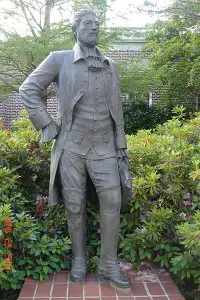
Don Antonio Gil Y’Barbo, simply known as Gil Y’Barbo, was a pioneer settler in the town Nacogdoches in Texas, USA. Born in 1729 to Spanish parents in what is now part of Los Adaes, Louisiana, Gil Y’Barbo made a lucrative career out of contraband trade involving contraband items like firearms and gunpowder. National Park Service dubbed him as a ‘œprolific trader and smuggler’. When Gil Y’Barbo led the Spanish settlers back to Nacogdoches, it had been abandoned by the colonial Spanish government for some years.
In 1779, it was his repeated effort that ultimately compelled the Spanish colonial government to allow the Spanish settlers to return to the eastern parts of Texas and stay in the abandoned settlement of Nacogdoches. This man was virtually the father of Nacogdoches as well as the Spanish Texas.
Here are some little known facts about this colourful character:
Although Gil Y’Barbo was Spanish by birth, he had never been to Spain. He spent his whole life in the Spanish colony of East Texas.
He indulged in a form of trade which was declared illegal by the Spanish colonial authority.
Although he was a trader, his original profession was that of a soldier.
Nacogdoches is the first official Spanish town to have been granted the status of a Pueblo by the colonial Spanish government.
He was part of an envoy that petitioned to the Viceroy himself for the permission to settle in East Texas.
Gil Y’Barbo became the first Lieutenant-Governor of the town of Nacogdoches.
The Texas State Highway 21 was actually laid out by Gil Y’Barbo. It was then named as El Camino Real. Y’Barbo also laid the La Calle Del Norte, which also exists till today as the Business U.S. Highway 59-F.
In 1791, Gil Y’Barbo constructed a two-storey stone building on the north-east part of the central plaza of the town of Nacogdoches. This structure was known as the La Casa Piedra, or literally ‘œStone House’. It served as a multi-purpose structure including a trading post and even a prison at times.
Although himself having a notorious reputation for dealing in contraband items or simply smuggling, Gil Y’Barbo was officially appointed as the judge of contraband seizures.
In 1790, he resigned as the Lieutenant-Governor and faced a trial in San Antonio for smuggling the next year. He was, however, acquitted of the charges.
Although not proven guilty, Gil Y’Barbo was forbidden to return to Nacogdoches for the rest of his life.
Gil Y’Barbo died in 1809 in La Lucana, on the Attoyac Bayou but was buried in Nacogdoches. His legacy still lives on, as he has been officially acclaimed as the father of the town of Nacogdoches.
In 1997, a statue of Gil Y’Barbo was erected in the central plaza of Nacogdoches.
Many of his descendants still live on in and around Nacogdoches as well as across Texas, Louisiana and other parts of the Southwest United States of America. Gil Y’Barbo is well remembered for the efforts he put in for claiming the rights of the Spaniards living in the United States.










Leave a Reply